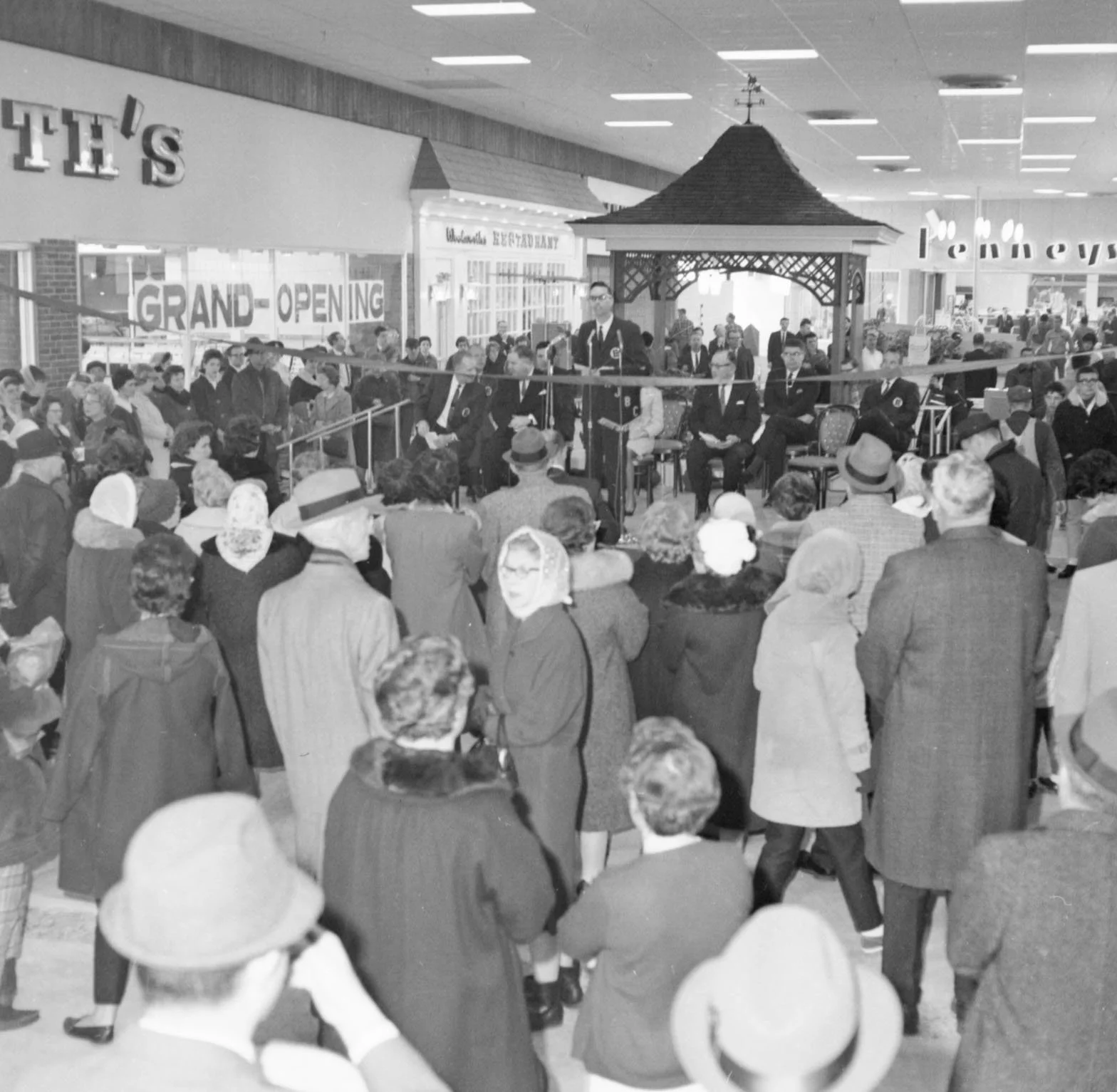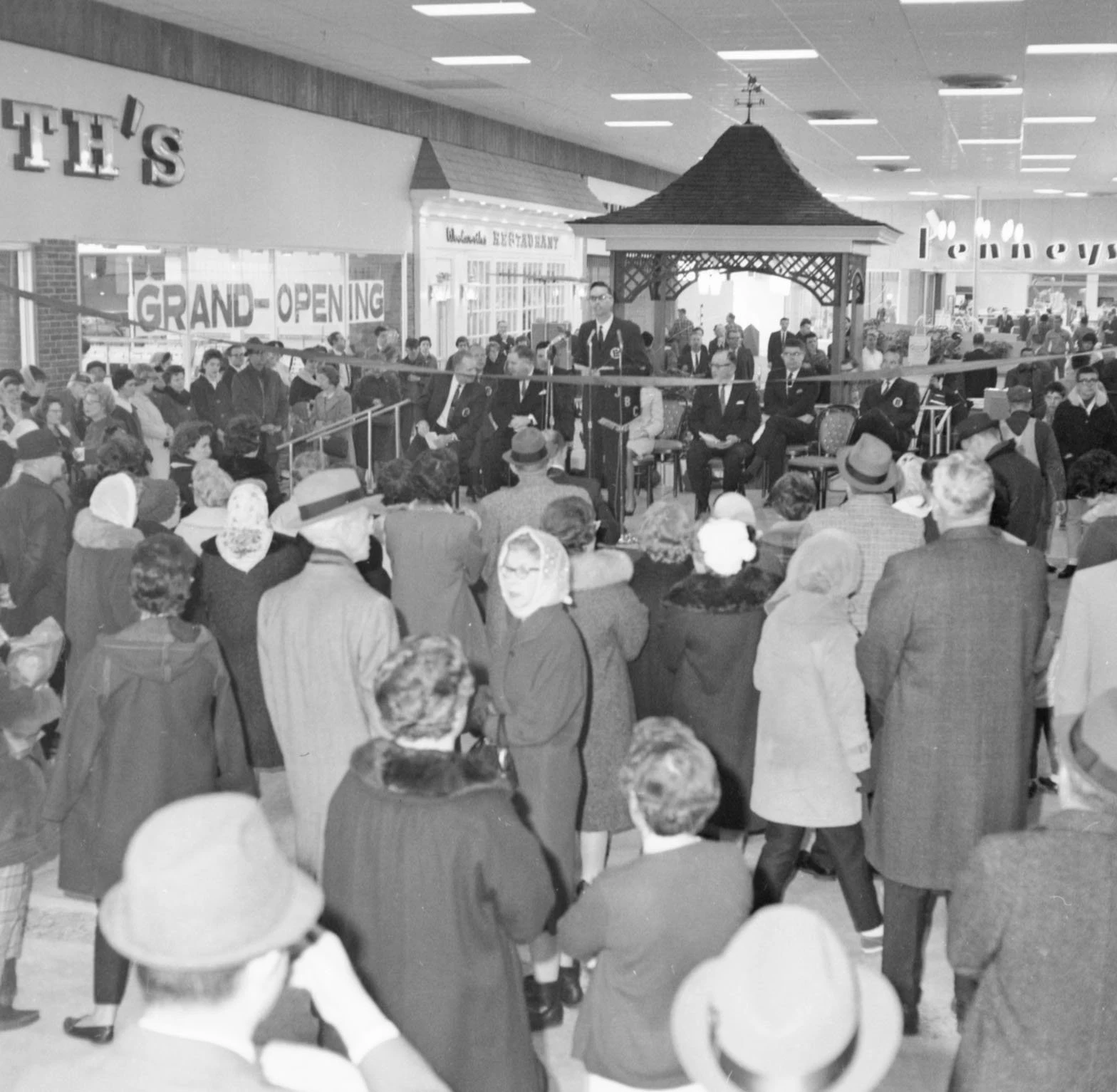“A shopping trip takes on all of the glamour and excitement of the space age when you visit the beautiful new Eastland Shopping Center.” Such was the sales pitch for the Feb. 16, 1967 ribbon cutting ceremony marking the formal debut of Bloomington’s indoor mall. The opening of Eastland more than a half century ago ranks as one of the more momentous events in Twin City history.
The mall hastened the flight of retailers large and small from downtown Bloomington, and by doing so cemented the city’s eastward pivot toward the U.S. Route 66 beltline (now Veterans Parkway.) The mall’s success, though, also meant Bloomington remained a regional center for out-of-town shoppers, as well as a dependable job creator and sales tax generator. Although less than 2½ miles separated the downtown district from the new indoor mall, they represented vastly different worlds, separated as they were in time by the emergence and then dominance of the automobile in American society.
Located at the junction of the Route 66 and Illinois Route 9, the $4.5 million 30-acre project was developed by Copaken Realty of Kansas City, Mo., and designed by Sidney H. Morris & Associates of Chicago. Other enclosed shopping centers credited to this architectural firm include Lakehurst Mall in Waukegan, Ill. (opened in 1971); Northwoods Mall in Peoria (1973); and Hickory Point Mall in Forsyth, Ill., on the north edge of Decatur (1978.)
Eastland was not the first retail center to stake its future on the fast-sprawling, automobile-friendly east side. The first phase of the Towanda Plaza development dates to the late 1950s, and Kmart opened across Route 9 from the mall’s future site on September 20, 1962. Yet those projects—and the many others to follow—never matched the size and ambition of Eastland Shopping Center (as the mall was first known.) Irwin Blitt of Copaken Realty appeared before Bloomington Rotarians in mid-October 1964 to trumpet the social and economic revolution wrought by the indoor mall, which was fast becoming a dominant symbol of the affluence and consumerism of postwar America. Blitt noted that during the past eight years, the number of shopping centers in the U.S. had increased from 2,200 to nearly 10,000. “Centers are opening up at a rate of three a day,” he told the gathered Rotarians. “This year, centers will do $50 billion in sales in 700 million square feet of floor space.”
Ground was broken for the Eastland project on Dec. 29, 1964. Rowe Construction Co. of Bloomington handled the grading work for the general contractor, Inland Construction Co. of Morton Grove, Ill. In many ways, the shopping center was defined not by its stores but by its acre upon acre of free parking—enough to accommodate 2,200 automobiles. Even more exciting to shoppers back then was the fact that there wasn’t a parking meter in sight! For an increasingly car-centric community and region, this advantage alone guaranteed Eastland’s success at the expense of downtown Bloomington.
Sears became the shopping center’s first tenant when it opened a 100,000 square foot store Feb. 17, 1966. The retailing juggernaut offered 51 merchandise departments, from infant wear to building materials. Customer services included “catalog ordering, decorator shop, gift wrapping, custom-made draperies [and] slip covers, and installation of fencing, floor covering, plumbing-heating, air conditioning and awnings and blinds.” In addition, the automotive service center featured an eight-bay garage.
J.C. Penney’s followed Sears to Eastland nine months later, opening on Nov. 10, 1966. The new Penney’s was four times as large as the one downtown, which had been located in the old Braley-Field Building at the northwest corner of the courthouse square (Maguire’s Bar and Grill now occupies the lower floor of this building.) Sears and Penney’s were then joined by an A&P grocery store, the mall’s first non-anchor tenant. By Jan. 1967, Eastland officials had lined up some 20 tenants, a half-dozen or more of which were local retailers with a downtown Bloomington presence, including Bachrach’s, a men’s clothing store; Chadband’s Jewelry; Murray’s Boot Shop; Musicland; Pines Smartwear; and W.H. Roland’s.
Also coming to Eastland were national or regional chains, such as Kinney Shoes, 31 Flavors Ice Cream, the Singer Co., Topsy’s Sidewalk Cafe, Walgreens (with the Grill Room restaurant) and Woolworth’s. It’s hard for us today to appreciate just how revolutionary indoor shopping centers were to postwar consumers. Eastland management promised local residents “a new dimension in shopping convenience.” The “Center Mall” connecting the department store anchors offered shoppers an enclosed, “climatized” environment. “Through the park-like enclosed mall,” declared Eastland management, “you can go from store to store without going outdoors, until all of your shopping is completed.”
Two fountains and indoor landscaping were added to give the mall a public square or Main Street feel. Another radical change for shoppers was that many of the retailers lining the mall were “open-fronted.” That is, they offered little in the way of walls or other barriers between the store’s interior and the mall, making it even easier to stroll about the all-weather “shopper’s paradise.”
Eastland Shopping Center’s official opening was held Thursday, Feb. 16. Some 300 to 350 eager shoppers and curious onlookers gathered at the mall’s “pagoda” for a ribbon-cutting ceremony (see accompanying photograph.) Al Pizzamiglio’s orchestra was there to provide music as folks explored the Center Mall and the eighteen newly opened stores. “The parking is free and easy and it’s always a comfortable 72 degrees in Eastland Shopping Center,” was the promise.
Eastland Mall (as the renamed shopping center became known) was a sustained success, at least before the so-called “retail apocalypse” of the past decade or so in which brick-and-mortar stores have faced ever-dwindling sales and cultural irrelevance. Long before the existential threat posed by online shopping, Eastland underwent several expansions. In the early 1970s, Bergner’s, the Twin City’s first new department store in decades, necessitated a major addition. The 1980s brought another department store, Kohl’s, as well as the food court. In the fall of 2002, Eastland Mall boasted occupancy rate of 98 percent and five anchors—Sears, Penney’s, Bergner’s, Famous-Barr and Kohl’s. Yet the brute efficiencies of Amazon and other online behemoths—their ability to offer low prices, selection and, most importantly, next-day delivery—have laid waste to malls across the nation, Eastland included. The Eastland of 2019 is a shadow of its former self, with Kohl’s the lone surviving anchor.
Yet unlike other malls that have been shuttered and bulldozed, Eastland has managed to attract a few new and nontraditional tenants. The former JCPenney store, for instance, is now occupied by H&M, a Swedish “fast fashion” retailer, and Planet Fitness, an exercise club.

